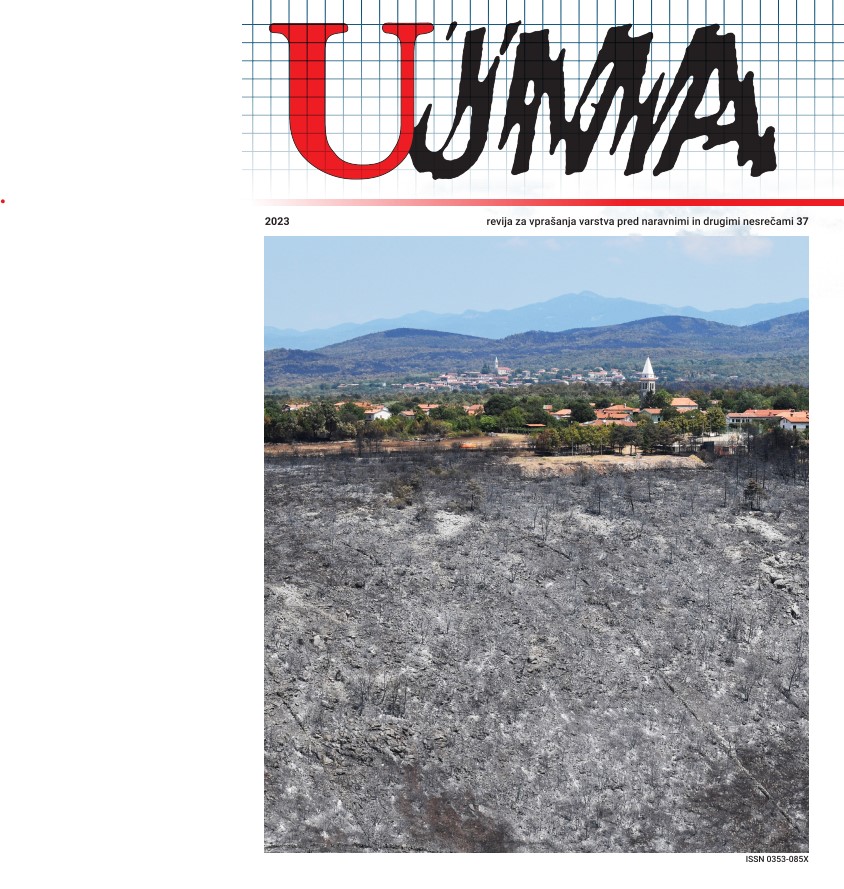THE IMPACT OF THE BEDLOAD TRANSPORT ON FLOOD RISK IN THE SAVA DOLINKA RIVER BASIN UP TO JESENICE
Abstract
In 2022, a joint partnership project was initiated to prepare the basis for a strategy of managing sediments in the Sava River basin. As part of this strategy, a two-dimensional model of the bedload transport was used to calculate quantities, balance, and key deposition and erosion locations in the most bedload-laden part of the Sava Dolinka River basin in north-western Slovenia. The term bedload refers to sediments that move along the riverbed or saltate in the water flow, remaining close to the riverbed, with particle sizes larger than 2 mm. Floating or suspended sediments, on the other hand, are sediments that travel freely during average and elevated water discharges, and are a consequence of soil particles erosion (Mikoš, 2012). They mainly consist of clays, silts, and fine sands. The boundary conditions of the bedload transport model were determined for three hydrological scenarios: a single event with a peak discharge of Q100, and for both a wet and a dry hydrological year. The results demonstrate the bedload transport capacity along individual sections of the model, representative areas with increased erosion depths, and, most importantly, the areas of increased sedimentary deposit thickness. Particular emphasis was given to identifying areas where excessive bedload accumulates, which could consequently increase the flood risk in the Sava Dolinka River basin up to Jesenice. The results of the bedload transport model, combined with expert estimates of the bedload transported quantities, together with field evaluations by water protection supervisors, identified locations of the potential flood risk increase is due to the significantly unbalanced transport capacity conditions in the Sava Dolinka River.
References
ARSO, 2022a. Padavinski podatki iz arhiva meritev padavinskih postaj ARSO. https://meteo.arso.gov.si/met/sl/app/webmet/#webmet==8Sdwx2bhR2cv0WZ0V2bvEGcw9ydlJWblR3LwVnaz9SYtVmYh9iclFGbt9SaulGdugXbsx3cs9mdl5WahxXYyNGapZXZ8tHZv1WYp5mOnMHbvZXZulWYnwCchJXYtVGdlJnOn0UQQdSf, 15. 4. 2022.
ARSO, 2022b. Hidrološki podatki iz hidrološkega arhiva ARSO. https://vode.arso.gov.si/hidarhiv, 20. 4. 2022.
Ashworth, P. J., Ferguson, R. I., 1989. Size‐selective entrainment of bed load in gravel bed streams. Water Resources Research, 25(4), 627–634. https://doi.org/10.1029/WR025i004p00627.
DRSV, 2022a. Podatki o odvzemih naplavin po koncesijskih območjih Save v obdobju 2014–2018. Mitja Centa z DRSV je posredoval po elektronski pošti, 15. 3. 2022.
DRSV, 2022b. Vodno zemljišče tekočih celinskih voda. http://www.evode.gov.si/index.php?id=104.
IZVO-R. 2019. Hidrološka analiza obravnavanih vodotokov. Poplavna študija za območje občine Kranjska Gora. H-46/14, G79-FR/14. Ljubljana.
Mikoš, M., 2012. Kalnost v rekah kot del erozijsko-sedimentacijskega kroga, Gradbeni vestnik, letnik 61, št. 6, 129–136.
MKGP, 2022. Podatki o rabi tal, različica 20220930, september 2022.
Pravilnik o metodologiji za določanje območij, ogroženih zaradi poplav in z njimi povezane erozije celinskih voda in morja, ter o načinu razvrščanja zemljišč v razrede ogroženosti. Uradni list RS, št. 60/07. http://www.pisrs.si/Pis.web/pregledPredpisa?id=PRAV8318.
Recking, A., in drugi, 2021. Contribution of grain sorting to the bedload active layer dynamics. HAL open science. https://hal.science/hal-03400273.
USBR, 2020. SRH-2D User Manual: Sediment Transport and Mobile-Bed Modeling. https://www.usbr.gov/tsc/techreferences/computer%20software/models/srh2d/downloads/SRH-2DSedimentTransptModelingUsersManual_V3.3_June2020_Final508.pdf.
Wu, W., Wang, S. S. Y., Jia, Y., 2000. Nonuniform sediment transport in alluvial rivers. Journal of Hydraulic Research, 38(6), 427–434.
Yochum, S. E., Comiti, F., Wohl, E., 2014. Photographic guidance for selecting flow resistance coefficients in high-gradient channels. https://www.researchgate.net/publication/266970182.
Downloads
Published
Issue
Section
License

This work is licensed under a Creative Commons Attribution-NonCommercial-NoDerivatives 4.0 International License.
The articles are made available to the public under Creative Commons Attribution-NonCommercial-NoDerivatives 4.0 International (CC BY-NC-ND 4.0).


